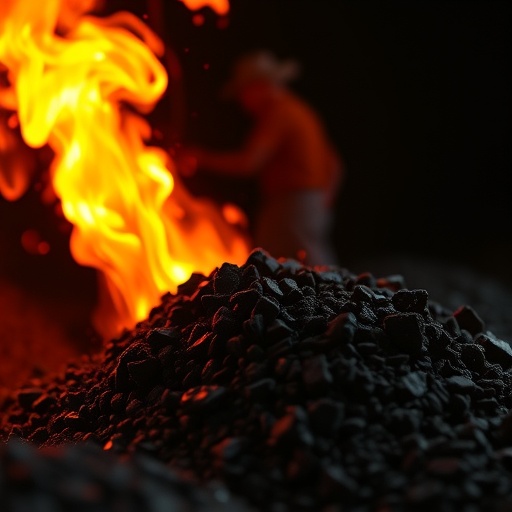In a groundbreaking study published in Natural Resources Research, researchers led by Zhang et al. presented compelling evidence regarding the particle size effects and acoustic emission characteristics of broken coal compaction and re-crushing. This research holds significant implications for the mining and energy industries, as understanding these processes is critical for optimizing resource extraction and improving safety protocols.
The study delves into the intricate relationship between the particle size of broken coal and its subsequent compaction behavior. It has long been understood that particle size can significantly influence the mechanical properties of materials. However, this new research systematically quantifies how variations in size lead to different compaction outcomes when coal is subject to stress, particularly in mining operations. Through rigorous experimentation, the authors provide a detailed analysis of these effects, shedding light on the underlying mechanisms at play.
Central to the study was the use of acoustic emission (AE) techniques to characterize the behavior of coal during compaction and re-crushing. Acoustic emissions are high-frequency stress waves that can be monitored to provide real-time insights into material behavior under load. Zhang and colleagues employed advanced sensors to capture acoustic signals generated during the breaking and compaction of coal particles. Their findings indicate that different particle sizes produce distinct patterns in acoustic emissions, which correlate to variations in strength and compaction properties.
The researchers meticulously dissected the acoustic emission data, drawing connections between specific frequency ranges and the physical responses of coal particles during stress application. This allows for early detection of failure points in coal structures, which can lead to catastrophic incidents if not monitored closely. The implications for safety in mining practices cannot be understated, as understanding the acoustic signatures of coal can help prevent accidents caused by unexpected collapses.
Moreover, the study examined the re-crushing process, a critical step in coal processing that influences the final quality and energy yield of coal products. As coal is repeatedly crushed, the particle size continues to change, impacting the compaction behavior and energy efficiency of the crushing operations. Zhang et al. discovered that finer particles exhibit a significantly different acoustic response when re-crushed compared to larger ones, indicating that the operational parameters in coal processing might require adjustments based on the particle size distribution.
One of the standout contributions of this research is the establishment of a relationship between acoustic emission characteristics and particle size. The authors developed a predictive model that links the observed acoustic emissions with the compaction behaviors of coal at various sizes. This model serves not only as a tool for researchers but also holds practical applications for engineers and operators in the industry, equipping them with a method to tailor operational conditions.
Furthermore, this work opens avenues for future investigations into optimizing crushing processes and improving energy efficiency in coal mining. By leveraging the insights gained from acoustic emissions and understanding the fundamental properties of broken coal, industry stakeholders can adopt a more data-driven approach to mineral processing. This could lead to significant cost savings and enhanced safety measures across the board.
In summary, Zhang et al. have provided a comprehensive study that highlights the importance of particle size in the context of coal compaction and re-crushing, employing advanced acoustic emission techniques to reveal crucial insights. The potential applications of their findings extend beyond academia into practical realms, influencing future mining operations, safety protocols, and efficiency strategies. As energy demands continue to rise globally, optimizing coal utilization through such innovative research is of paramount importance.
The publication itself, alongside its supporting data, is poised to generate a great deal of interest both in scientific circles and within the industry. Following the publication, experts are expected to conduct further studies to validate and expand upon these findings. The research can serve as a foundation for additional experiments aimed at refining coal processing techniques further, which could eventually lead to enhanced energy outputs and lower environmental impacts for this vital resource.
The interdisciplinary nature of the study, which fuses geology, engineering, and acoustics, exemplifies the innovative approaches necessary for tackling contemporary challenges in resource extraction and energy production. The advantages offered by this research could very well spark advancements in various related fields, further solidifying the significance of understanding particle dynamics in various materials.
As the field continues to evolve, it will be exciting to see how Zhang et al.’s contributions shape future research initiatives and practical applications in coal mining and beyond, underscoring the need for continued exploration and innovation in resource management.
Subject of Research: Particle Size Effect and Acoustic Emission Characterization of Broken Coal Compaction and Re-Crushing
Article Title: Particle Size Effect and Acoustic Emission Characterization of Broken Coal Compaction and Re-Crushing.
Article References:
Zhang, C., Chen, Y., Wu, R. et al. Particle Size Effect and Acoustic Emission Characterization of Broken Coal Compaction and Re-Crushing.
Nat Resour Res (2025). https://doi.org/10.1007/s11053-025-10576-w
Image Credits: AI Generated
DOI: https://doi.org/10.1007/s11053-025-10576-w
Keywords: coal, particle size, acoustic emission, compaction, re-crushing, mining, energy efficiency, safety protocols




